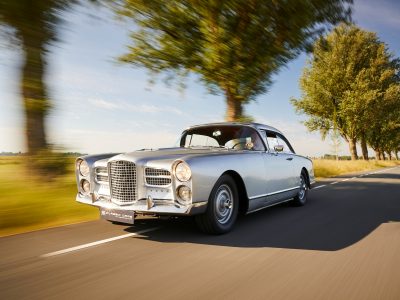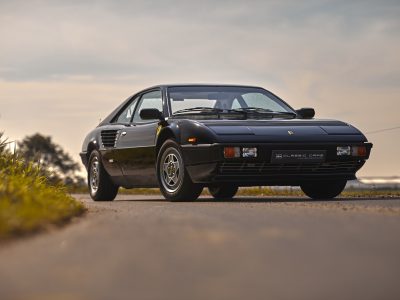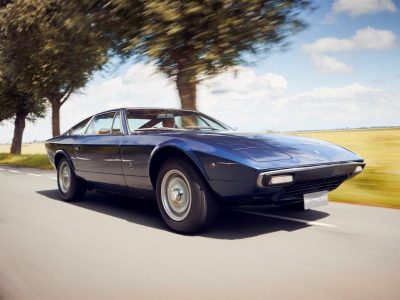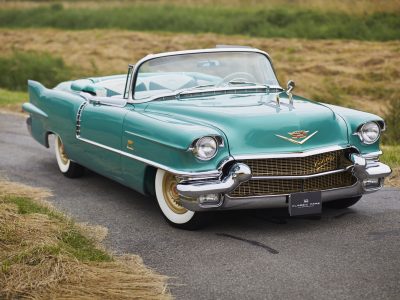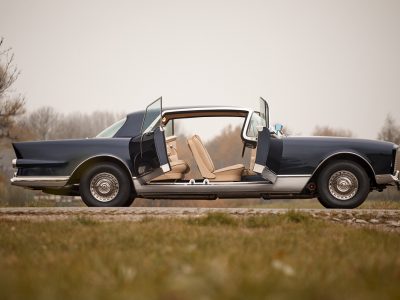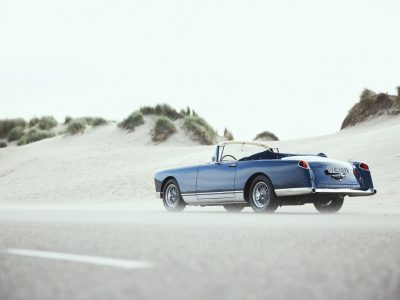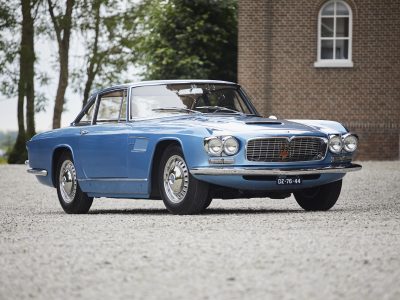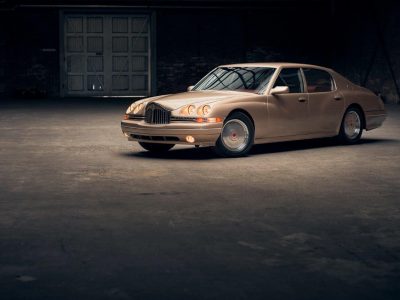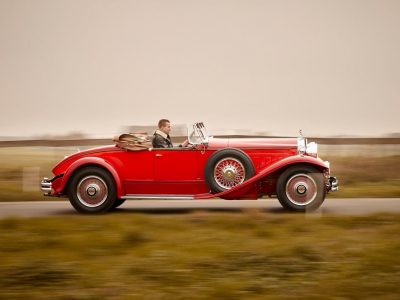DESIGN STUDY BY JB CLASSIC CARS
Simca 8 Sport Coupé
Some cars have beauty in all their veins. No study about the Simca 8 Sport Coupé would be complete if you would give credits to Pininfarina. The Italian coachbuilder and master designer is mentioned in almost every story about this little French sports car. But other than most stories will tell you, you’ll have to dig a little bit deeper to find the missing links in this Simca’s story.
Let’s start with the briljant designer Giovanni Savonuzzi. Right after WWII Giovanni Savonuzzi sketched his ideas for what would become the Cisitalia 202, after he had already penned other successful Cisitalias. Based on science instead of emotions he created efficient car bodies – using wind tunnel testing – with Mille Miglia victories in mind. But even Savonuzzi didn’t start with a blank sheet of paper. A couple of years before, Italy still being at war, the Italian industrialist and founder of Cisitalia, Piero Dusio, hired Dante Giacosa to design a single seat racing car, the D46. Giacosa was employed by Fiat, but he did his work for Cisitalia in his spare time and was allowed to do so by his employer.
It’s important to understand that Dante Giacosa developed road- and race winning Fiats before the war. Based on his pre-war technology cars like the Fiat Millecento and 1100, Simca 8 and Cisitalia 202 were created. His 1100cc engine with overhead cam and other groundbreaking components were used by many ‘carrozzeria’, which Fiat happily supplied. Although Fiat itself was focused on mass production all cars were technically related. This meant racing these cars was quite competitive and driven by innovation. Giacosa didn’t limit himself to one aspect of car design, but he developed engines, drivetrains and chassis structures. Dante Giacosa was one of Italy’s greatest car designers and he played an important role in the automotive industry for many decades. In case of the Cisitalia 202 he set up the initial design, before he passed over responsibility for the final design to Giovanni Savonuzzi.
In 1946 Savonuzzi took this design to coachbuilder Carrozzeria Pinin Farina on behalf of Cisitalia. Battista “Pinin” Farina re-styled the design a bit so it could go into their production. In fact it was a young Giovanni Michelotti who was entrusted with the adaptation of lines of the Cisitalia to the proportions of the frame of the Fiat 1100 S – the car it was based on. When it comes to metal shaping, the Farina brothers were ahead of the game.
Just before the car’s introduction Savonuzzi left the factory to become freelance designer, but he still was being hired by Piero Dusio. Battista Farina took credit for the Cisitalia 202 design and used it as a blueprint for the Ferrari 166 Inter – Ferrari’s first gran turismo, also built by his brother’s Stabilimenti Farina – and Simca 8 Sport, which was built by Facel-Métallon. When asked, Giovanni Savonuzzi always gave credit to Pinin Farina for these designs, although the finished cars aren’t that different from his initial drawings. But the design study doesn’t stop there.
Savonuzzi’s knowledge of aerodynamics was ahead of its time. His sleek designs were even tested as wooden models in the wind tunnel. He could use this as he taught Aeronautics at the Polytechnic of Turin during all his career. To prove the advantage of having improved efficiency you can see the top speed for the single carbureted versions of the Cisitalia 202, Ferrari 166 Inter and Simca 8 Sport don’t differ that much. The 2-litre V12 powered Ferrari is only 15 kmh faster than the Simca, despite having a humble 40 hp extra in single carb trim. But as soon as the Italians added double twin-choke Webers or even the bigger 2.8L litre BPM engine (Cisitalia 202D), these cars got wings.
Simca never built faster versions, because French authorities wouldn’t let them. The Simca 8 Sport Cabriolet was capable of 135 kmh, which easily doubled the top speed of a 2cv in period. France lacked highways back in those days and with the Sport 8 driving from one town to another in the French countryside and through villages was a treat. Top speed was less important than average speed, and this is where the Simca stood out. The Cabriolet got the proven 1100cc at first. When production began the larger 1221cc engine was fitted. In fact it was SIMCA who was able to use the newer 1221cc FIAT engines before the Italian company started to use these themselves. These newer and more efficient engines were developed by no one less than Dante Giacosa again. He used the same architecture from this design for his invention of a front-wheel-drive FIAT in 1947, years ahead of Alec Issigonis. The Italian master engineer actually designed and patented a front-wheel drive drivetrain centered around a transversally-mounted engine in 1947. A lot happened in post-war Italy.
It was never the plan to create a french version of the Fiat 1100 Cabriolet Farina nor Cisitalia, it just happened because of several coincidences. Henri Pigozzi, Simca’s founder, visited Stabilimenti Farina in Turin when he saw a bespoke Fiat 1100 Cabriolet he immediately fell in love with. Stabilimenti Farina did not just build this Cabriolet, they also owned the copyrights of Pinin Farina’s design. The same design was used for the Ferrari 166 Inter they built for Ferrari – an assignment by Pinin Farina. Pigozzi – a born Italian who moved to Paris – still had many friends in Turin. One was Gianni Agnelli himself after Pigozzi proved himself as a successful business partner in France. Pigozzi’s other friend was Pietro Perrone, who was running the Stabilimenti Farina workshop as a manager. Because Henri Pigozzi was respected for his achievements, all stakeholders – led by FIAT’s CEO Vittorio Valletta and the young playboy Gianni Agnelli who just became vice president after his grandfather had died – gave their approval to take a FIAT 1100 Cabriolet Farina to the Salon Auto, the Paris motor show in 1948. Perrone drove a Fiat to Paris, where he met Pigozzi. They simply replaced the Fiat badges with Simca logos, cleaned the car and showed it to the world as the new Simca Sport concept car. Because it was received well, Pigozzi got permission to build it in series. There was only one problem left. Simca wasn’t able to create such a coachbuilt car in series. Stabilimenti Farina itself could, but import taxes then would have increased the car’s selling price by around 60%.
Facel-Métallon got the order for building the Simca 8 Sport by Simca. Facel already produced Simca bodywork, including the regular Simca 8 models. Facel founder Jean Daninos did not just have great experience with the production of metal bodywork in series, but he’d also created several bespoke Citroens in the 30s when he was still part of their design team. There he was responsible for the Rosalie and Traction Avant one-offs and he helped to set up the production line for the regular Traction Avants and its unibody structure development that was implemented on that line. Besides this experience Daninos was already familiar with Pinin Farina. He had just let Farina design the Bentley Cresta, a concept he had developed in cooperation with Rolls Royce. Both Simca and Facel factories were almost literally based around each other’s corner and were surrounded with other workshops full of Parisian specialists who already knew how to work on the highest level of that time.
Because FIAT saw the benefits of the Italo-French collaboration they did not just send Perrone to France, but the legendary car designer Count Mario Revelli di Beaumont got involved as well. Although he kept tight connections to FIAT he’d work on Simcas from the late forties till early sixties, but he helped Facel with several car designs until Facel went out of business. Pietro Perrone mentioned the mind blowing design qualities of Jean Danino in an interview: “During 18 months we had the opportunity to develop a coupé, based on the cabriolet. It was the obvious choice to use sheet metal to create a roof, but its design needed to stay in harmony with the rest of the car’s styling. During this process I realized the great talent for design our “boss” Jean Daninos had. At the reception in the Museum of Modern Art in New York he explained why they decided to make the Simca 8 Sport look like a Cisitalia 202 by saying: “The resemblance to the Cisitalia coupés was intentional. It was for us a reference”.
The Simca 8 Sport Coupé is probably the only car in the world that has been designed and developed, both directly and indirectly, by more industry leading designers and engineers than any other car, without becoming a hodgepodge. Instead of competing against each other, they unwittingly evolved an already fine design into the next and this natural approach worked, although this was not part of any plan. Because in the end the Simca 8 Sport’s path was just littered with coincidences. Perhaps this was part of this post-war joined-forces mindset, but each conjunction convinced stakeholders on all sides. It just made sense to allow others to hop on the same bus that travelled back and forth between Paris and Turin. As a result the Simca 8 Sport Coupé symbolises the cooperative approach more than its counterparts from Ferrari and Cisitalia. Without Facel it wouldn’t have been impossible to produce these extraordinary cars at such a scale.

